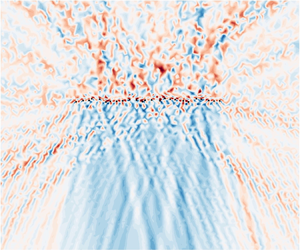Article contents
Hydrodynamics of large wave energy converter arrays with random configuration variations
Published online by Cambridge University Press: 21 July 2021
Abstract

We study the effect of random perturbations of body positions in large uniformly spaced arrays of axisymmetric wave energy converters (WECs). We perform systematic computational simulations of ensembles of randomized array configurations that are obtained by introducing zero-mean position perturbations (characterized by randomness parameter  $\varepsilon$) to line arrays of uniform spacing
$\varepsilon$) to line arrays of uniform spacing  $d$. Of special interest are the conditions under which these randomized arrays can extract more energy than the underlying uniform arrays. We find that random WEC arrays achieve substantial energy extraction gains over the same number of isolated bodies in monochromatic and irregular incident seas. Introducing
$d$. Of special interest are the conditions under which these randomized arrays can extract more energy than the underlying uniform arrays. We find that random WEC arrays achieve substantial energy extraction gains over the same number of isolated bodies in monochromatic and irregular incident seas. Introducing  $\varepsilon >0$ acts to smooth out the uneven performance of uniformly spaced arrays over varying incident wavenumber. In the low-scattering regime, the standard deviation of array gain grows with the square of wavenumber, for which we provide a theoretical explanation. We show that the uniform line array with spacing optimized for a given incident spectrum generally outperforms randomized arrays of any mean
$\varepsilon >0$ acts to smooth out the uneven performance of uniformly spaced arrays over varying incident wavenumber. In the low-scattering regime, the standard deviation of array gain grows with the square of wavenumber, for which we provide a theoretical explanation. We show that the uniform line array with spacing optimized for a given incident spectrum generally outperforms randomized arrays of any mean  $d$ and
$d$ and  $\varepsilon$ in that spectrum, and we offer a heuristic explanation. This holds for a wide range of incident spectra.
$\varepsilon$ in that spectrum, and we offer a heuristic explanation. This holds for a wide range of incident spectra.
- Type
- JFM Rapids
- Information
- Copyright
- © The Author(s), 2021. Published by Cambridge University Press
References
REFERENCES
- 4
- Cited by





